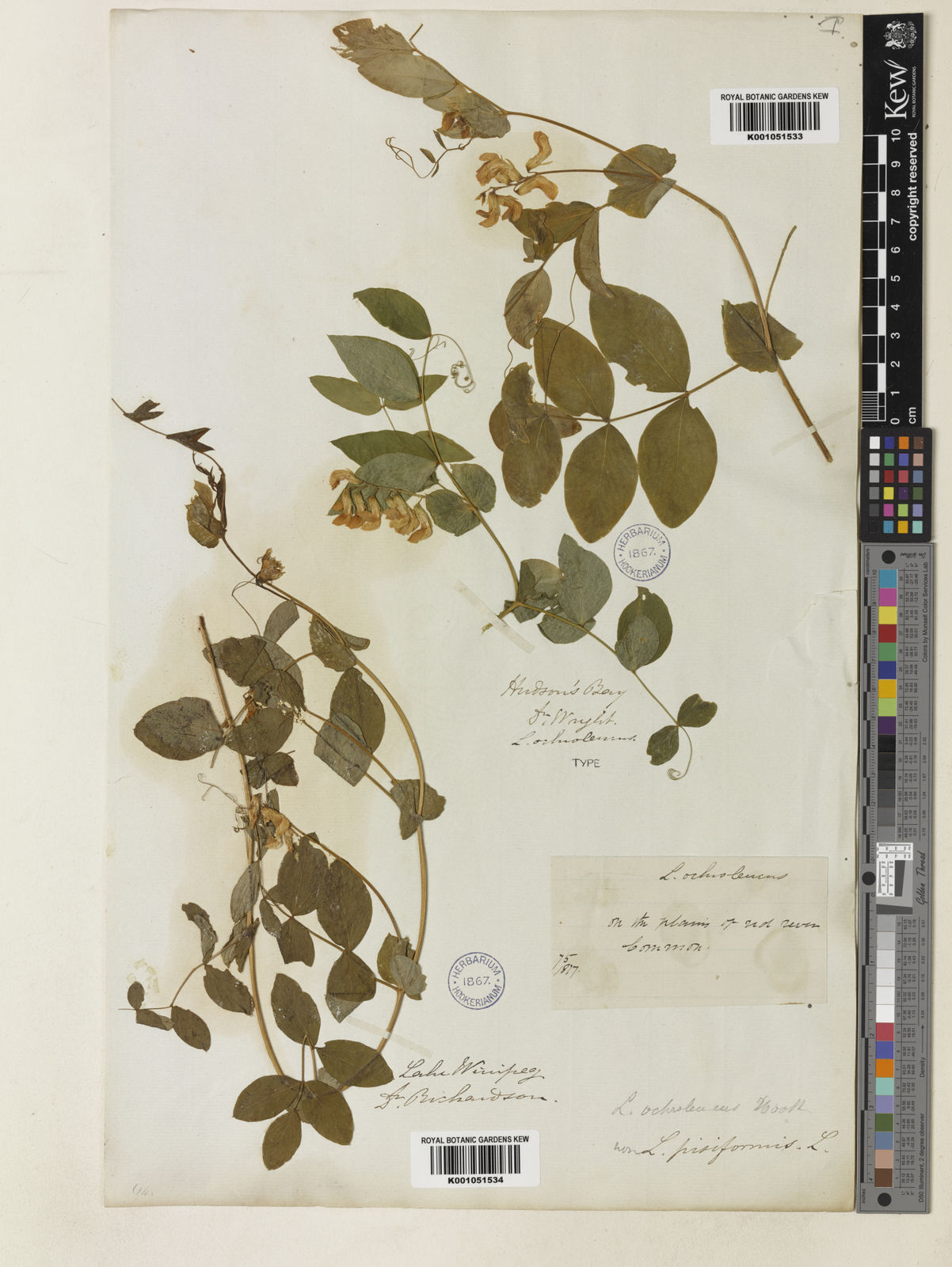Family: Fabaceae
Author: Hook.
Bibliography: Fl. Bor.-Amer. 1: 159 (1831)
Year: 1831
Status: accepted
Rank: species
Genus: Lathyrus
Vegetable: Unknown
Observations: Subarctic America to N. U.S.A.
Description
Pale vetchling, known scientifically as Lathyrus ochroleucus, is a perennial plant belonging to the Fabaceae family. Described by the botanist Hook. in the Flora Boreali-Americana, the plant was first documented in 1831. This delicate member of the legume family is notable for its adaptability to cooler climates, as it is found across a broad range of territories stretching from subarctic regions of North America down to the northern United States.
The pale vetchling is distinguished by its climbing or sprawling growth habit, typically reaching for support from surrounding vegetation. This allows it to thrive in various natural settings, from open woodlands to forest edges, where it often entwines around shrubs and other plants. The slender stems of Lathyrus ochroleucus bear deciduous leaves that are pinnately compound, featuring pairs of lance-shaped leaflets.
The plant’s most striking feature is its pale, creamy-yellow flowers. These delicate blossoms emerge in late spring to early summer, arranged in loose clusters. Each flower exhibits the characteristic shape of the pea family, with a broad banner petal, wings, and a keel. This configuration not only makes the flowers visually appealing but also efficient at attracting pollinators, such as bees, which play a crucial role in the plant’s reproductive cycle.
In their natural habitat, pale vetchlings contribute significantly to the local ecosystem. Being a leguminous plant, Lathyrus ochroleucus is involved in nitrogen-fixation, a process that enriches the soil by converting atmospheric nitrogen into a form that can be utilized by other plants. This symbiotic relationship with nitrogen-fixing bacteria in its root nodules fosters healthier plant communities and improves soil fertility.
Pale vetchling has adapted well to the climatic conditions of its native range. Despite its delicate appearance, the plant is moderately resilient, tolerating the cold temperatures of subarctic regions and the varied climatic conditions found in northern parts of the United States. Its preference for well-drained soils and partly shaded areas reflects its adaptability and ecological niche.
This species, though not as widely known as other members of the Fabaceae family, holds a distinctive place in the flora of North America. Its subtle beauty, ecological benefits, and historical documentation make Lathyrus ochroleucus an interesting subject of study for botanists and plant enthusiasts alike. Whether addressing the needs of natural ecosystems or appreciating its delicate blooms, the pale vetchling stands as a testament to the diversity and complexity of plant life in subarctic and northern temperate regions.
Common Names
Eng: cream pea, pale vetchling, pale vetchling peavine, yellow vetchling, cream-coloured vetchling, cream vetchling, cream-coloured peavine, cream-flowered peavine, creamy peavine
Fra: gesse jaunâtre
En: Pale vetchling, Yellow vetchling, Cream pea, CREAM PEAVINE, Pale vetchling peavine, Cream-coloured vetchling, Cream vetchling, Cream-coloured peavine, Cream-flowered peavine, Creamy peavine
Fr: Gesse jaunâtre
Synonyms
- Lathyrus albidus (Aikin ex Eaton)
- Ervum ochroleucum ((Hook.) Alef.)
- Lathyrus glaucifolius (L.C.Beck)
Distribution
- Alaska (native)
- Alberta (native)
- British Columbia (native)
- Idaho (native)
- Illinois (native)
- Iowa (native)
- Manitoba (native)
- Michigan (native)
- Minnesota (native)
- Montana (native)
- New York (native)
- North Dakota (native)
- Nunavut (native)
- Ontario (native)
- Pennsylvania (native)
- Québec (native)
- Saskatchewan (native)
- South Dakota (native)
- Vermont (native)
- Washington (native)
- Wisconsin (native)
- Wyoming (native)
- Yukon (native)
Additional Images
Leaf
Taken May 30, 2021 by Danielle Mccloy (cc-by-sa)
Taken Jun 3, 2022 by elisabeth vanheerden (cc-by-sa)
Taken Jun 15, 2022 by Eric Larsen (cc-by-sa)
Taken Jun 16, 2020 by justin klamut (cc-by-sa)
Taken Sep 28, 2021 by H Lou (cc-by-sa)
Habit
Taken Jun 16, 2006 by Andrew Gagg (cc-by-sa)
Flower
Taken Jan 1, 1900 by EOL − John Hilty (cc-by-nc)
Taken Jun 29, 2020 by Savannah (cc-by-sa)
Taken Jun 27, 2020 by Savannah (cc-by-sa)
Taken Nov 17, 2022 by Vinay sony (cc-by-sa)
Taken Apr 28, 2021 by divya Andayil (cc-by-sa)

© copyright of the Board of Trustees of the Royal Botanic Gardens, Kew.
Sources
- WFO (No URL)
- IPNI (No URL)
- GBIF (https://www.gbif.org/species/5356371)
- POWO (http://powo.science.kew.org/taxon/urn:lsid:ipni.org:names:501905-1)
- PlantNet (https://identify.plantnet.org/species/the-plant-list/Lathyrus ochroleucus Hook.)











